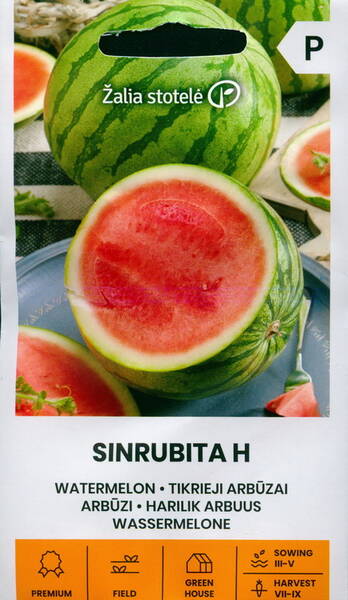A triploid hybrid of watermelon with sugary red flesh. Fruit weight 4-6 kg.
Agricultural technology.
Watermelon is grown in open ground and greenhouses, on light air- and water-permeable soils. Sowing is approximately in May, when the soil warms up to a depth of 8-10 cm to + 15 + 16 ° С. Planting pattern 140x100 cm. In greenhouses 70x70 cm, using trellises, (fruits can be hung in nets).
Before sowing, the seeds are treated in a solution of potassium permanganate, then washed with clean water. Seedling method of cultivation is also used. In this case, seedlings are planted after the last frost at the age of 3-4 true leaves. As the plants grow, they form into one stem, removing lateral shoots and leaving 2-3 ovaries on it (the rest are removed).
Further care consists of moderate watering, loosening, fertilizing and powdering the lashes to protect them from turning over by the wind.
* DO NOT OVERWATER.
Watermelons are grown in a greenhouse only vertically - they tie the lashes to the supports of the greenhouse, distributing them so as to avoid the slightest shading of the plants.
Watermelon is a drought-resistant crop, so small waterings are enough about 1 time in 7-10 days and only with warm water. In this case, the root collar area should be protected due to the risk of root rot. A good solution may be to use such an irrigation system, when water is not introduced from above, but spreads inside the ridges through the holes intended for this. The easiest way is to use plastic bottles evenly spaced around the plants and partially buried in the soil for watering.
* During the period of fruit ripening, watering is stopped - this speeds up the ripening process and makes watermelons sweeter.
Particular attention should be paid to the humidity in the greenhouse, remembering that watermelons prefer dry air (especially during flowering and fruit ripening).
Please note that one of the "pros" of using indoor irrigation technology is the ability to avoid rising humidity. In addition, one must not forget about the dangers of condensate - in no case should plants be covered with its destructive drops, because sooner or later this will lead to the development of fungal diseases and, as a result, their death. The correct design of the greenhouse, the use of polycarbonate instead of glass and film, regular ventilation, limited watering and covering the soil around the plants with covering material will help to avoid condensation.
* Jam made from watermelon rinds.
Ingredients: 1 kg of prepared watermelon rinds, 1.2 kg of sugar, 2 tbsp. spoons of water, 1/2 teaspoon of citric acid.
1. Cut off the green peel from the rind, then cut the white part into 2 cm thick cubes.
2. Blanch them in boiling water for 2-5 minutes, remove, cool, cover with some sugar for 2-3 hours.
3. Boil syrup from the remaining sugar and two glasses of water and pour it over the cubes for 8 hours.
4. Drain the syrup, bring to a boil and pour over the cubes again.
5. Repeat the procedure, and then cook over low heat until a drop of syrup stops spreading over the surface.
6. Add citric acid 5 minutes before the end of cooking.
7. Place into jars and cover with lids.
Store at room temperature.















